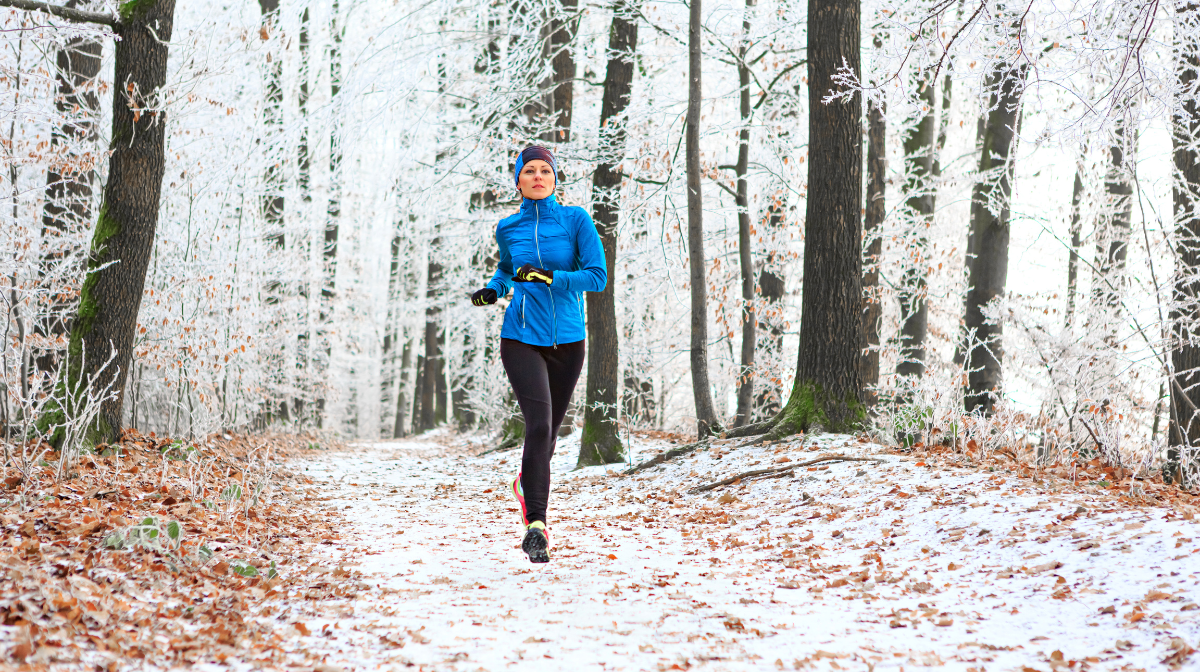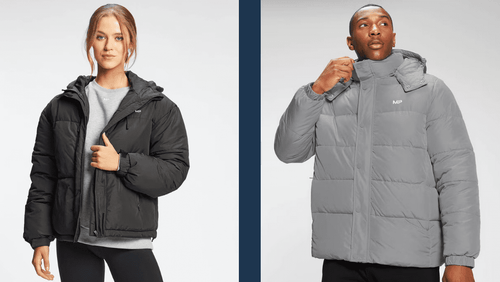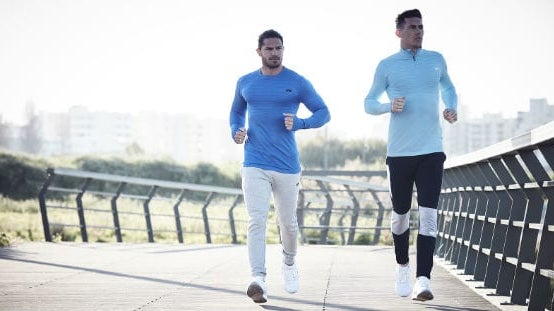
It's officially winter and that means it's getting cold—really cold. Although the days are shorter and temperatures are down, it's still just as important as ever to get your daily exercise in.
But before jumping right into exercising in the cold, you should ensure you're properly prepared and your body is protected. Here are seven top tips for working out in cold weather to get you through the winter.
1. Dress Warm
Across the US, most states will experience some pretty cold temperatures throughout the winter. For this reason, it's essential that you dress for the season if you're planning on working out outdoors.
The secret for keeping warm on those cold winter days and nights? Layers. For this season, layers are your best friend, and you can play around with specific materials to suit your workout.
When exercising, it's always a good call to have a moisture-wicking layer. This helps you to avoid sweat and not overheat.
A second layer that is super useful for cold weather is an insulating layer. Insulation will trap your body heat, keeping you warm without having to wear a puffy jacket. Insulated layers are often made with thin material and can slide on easily under your other clothes.
Lastly, if you're going to be moving around in winter weather, wearing something wind-resistant and waterproof can do wonders for harsh weather days.
You can wear this layer as either your outermost layer or underneath your insulation layer. You'll need this layer to prevent moisture from getting underneath your other clothing, and wind from getting through and making you cold.
The great thing about layers is you can change them up and adjust them to whatever weather conditions you're expecting.
For some of our best winter pieces, check out the article below:

Winter Activewear Essentials | Men and Women
Get ready to take on the cold with these winter wardrobe essentials. ...
2. Protect Your Extremities
When exercising in harsh weather, it's crucial you protect the sensitive areas of your body. Areas like your ears, hands, and feet are the most vulnerable to the cold and developing frostbite.
So, when running or moving outside, remember to wear something to cover your ears like a hat or ear muffs, quality socks for your feet, and gloves to protect your hands.
3. Warm-Up Properly
Warming up is always useful before a workout but is especially vital when exercising in the cold. When the temperature outside is colder than that of your body, you can lose a significant amount of heat.1
When this happens, your muscles and joints can become stiff and you may not be able to perform as well. By warming up, you can slowly heat up your muscles, allowing them to be more flexible for your workout. This will also help prevent injury as the muscles will move more fluidly.
The loss of heat in cold weather can also reduce blood flow. Warming up will get your blood pumping to your muscles, giving them access to more oxygen and nutrients.
Finally, warming up will also help increase your heart rate, regulate your body temperature, and allow your lungs a chance to adapt to the cold air, all helping you prepare for exercising in the cold.2
4. Stay Hydrated
You may not crave water as much in the winter as you do in the summer, but staying hydrated is still super important when exercising in the cold.
Even in the cold, when you exercise, your body will naturally produce heat and sweat. This loss of fluid needs to be compensated for by drinking water or other fluids, or you'll get dehydrated.2
In the winter, it's easier to not notice how much you are sweating as your sweat will evaporate quicker in cold weather. This makes it essential to stay hydrated to ensure you are not losing too much fluid.
In colder weather, your body will also lose more water through respiration because it has to heat up the cold air you breathe in before it can enter the lungs.3
For these reasons, it's vital to remember to stay hydrated when exercising outdoors in the winter.
5. Be Wary of the Weather
Safety is always a priority when it comes to exercising and when running or working out in the winter, it's important to be aware of harsh weather conditions.
Ice, snow, and high-speed winds can all pose a threat to safety and increase your chances of falling and getting injured. Additionally, very low temperatures can increase the chance of hypothermia, a condition where your body loses heat faster than it can produce it, causing body temperature to drop dangerously low.4
Plus, you're at even greater risk when exercising in the cold, as sweat can increase wetness and cold injury risk5.
So, if you're planning to get your physical activity outside in the winter, always check the forecast to ensure conditions are safe. In the case of winter storms or intense cold, taking a break from training outdoors and doing an indoor workout instead might be the safest option.
6. Stay Visible
The shorter daylight hours and weather conditions can make it harder to be visible when outdoors in the winter. This can increase the chance of an accident or injury, especially in public areas with drivers and cyclists going by.
So, if you're exercising outside during the cold season, it's especially important to make yourself as visible as possible and improve your own visibility of your path.
You can make it easier for people to see you by wearing reflective clothing or gear, lights like a headlamp or blinking lights, and bright or neon colors.
Wearing a headlight will also make it easier for you to see your path in dark or foggy conditions.
Some general safety tips for exercising outside in the winter are:
- Finding well-lit areas to exercise
- Exercising with others
- Sending people your location
7. Do What Makes You Comfortable
Everyone responds differently to the cold, and an individual's tolerance can be influenced by many factors including fitness level, acclimatization to the cold, and even genetic predispositions.
So, just like with any exercise, it's crucial to listen to your body to tell you your tolerance.
It's best to start off slow and see what level of intensity and duration you can handle in the cold. If you're becoming very uncomfortable, shivering excessively, or having difficulty breathing, adjust your routine to make it easier on your body.
For example, if you've been doing HIIT exercises outside but are now feeling uncomfortable in the cold, try jogging or a low-impact activity like power walking instead.
Remember, the goal of exercise is to enhance your health, not put it at risk.
Take Home Message
The cold doesn't have to stop you from your usual routine, but exercising outdoors in the winter can be dangerous if not done properly. Follow these tips to have safe, comfortable, and effective workouts this winter. Keep on that grind all year-round, you've got this.
READ THESE NEXT:

Why You Should Join a Gym This Winter
The new year is upon us and it's the perfect time to get down to the gym....

7 Easy Ways To Supercharge Your Immune System
Stay feeling your best with nutritionist-approved advice....

Mental Health Toolkit Featuring The Bottled Up Blokes
Tips for starting important conversations....

A Rutgers University Honors graduate, Jamie grew up on the Jersey shore and double majored in Comparative Literature and Anthropology in college. Jamie is an experienced writer in the health and wellness, biotech, and eCommerce fields. She loves writing with a purpose and has even written for the Department of Justice.
Jamie became drawn to exercise during her time in university and began to notice the physical and mental benefits of moving your body daily. Today, Jamie enjoys Pilates, light weight training, and going on long walks in nature daily.
Jamie is also passionate about eating right and prioritizing gut health and immunity. She is always trying the next innovation in health and wellness. When she’s not writing articles, Jamie enjoys reading, playing guitar, and finding dogs to play with.
- Sawka, M. N., & Young, A. J. (2006). Physiological Symptoms and Their Responses to Conditions of Heat and Cold. https://apps.dtic.mil/sti/pdfs/ADA448266.pdf
- Racinais S, Cocking S, Périard JD. Sports and environmental temperature: From warming-up to heating-up. Temperature (Austin). 2017 Aug 4;4(3):227-257. doi: 10.1080/23328940.2017.1356427. PMID: 28944269; PMCID: PMC5605167.
- D’Amato, M., Molino, A., Calabrese, G. et al. The impact of cold on the respiratory tract and its consequences to respiratory health. Clin Transl Allergy 8, 20 (2018). https://doi.org/10.1186/s13601-018-0208-9
- Staff, M. C. (2022, March 5). Hypothermia. https://www.mayoclinic.org/diseases-conditions/hypothermia/symptoms-causes/syc-20352682
- Fudge J. Exercise in the Cold: Preventing and Managing Hypothermia and Frostbite Injury. Sports Health. 2016;8(2):133-139. doi:10.1177/1941738116630542


















